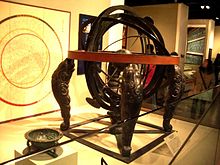Huihui Lifa

The Huihui Lifa (Traditional Chinese: 回回歷法; Simplified Chinese: 回回历法; pinyin: Huíhuí Lìfǎ) was a set of astronomical tables published throughout China from the time of the Ming Dynasty in the late 14th century through the early 18th century. The tables were based on a translation into Chinese of the Zij (Islamic astronomical tables), the title Huihui Lifa literally meaning "Muslim System of Calendar Astronomy".
History[]
Around 1384, during the Ming Dynasty, Hongwu Emperor ordered the Chinese translation and compilation of Islamic astronomical tables, a task that was carried out by the scholars , a Muslim astronomer, and , a Chinese scholar-official.
These tables came to be known as the Huihui Lifa (Muslim System of Calendrical Astronomy), and were published in China a number of times until the early 18th century,[1] despite the fact the Qing Dynasty had officially abandoned the tradition of Chinese-Islamic astronomy in 1659.[1]
Study of the Huihui Lifa in Korea[]

In the early Joseon period, the Islamic calendar served as a basis for calendar reform owing to its superior accuracy over the existing Chinese-based calendars.[2] A Korean translation of the Huihui Lifa was studied in Korea under the Joseon Dynasty during the time of Sejong in the 15th century.[1] The tradition of Chinese-Islamic astronomy survived in Korea until the early 19th century.[1]
See also[]
- Chinese astronomy
- Islamic astronomy
- Ming dynasty
References[]
- ^ a b c d Yunli Shi (January 2003), "The Korean Adaptation of the Chinese-Islamic Astronomical Tables", Archive for History of Exact Sciences, Springer, 57 (1): 25–60 [26], doi:10.1007/s00407-002-0060-z, ISSN 1432-0657, S2CID 120199426
- ^ Baker, Don (Winter 2006). "Islam Struggles for a Toehold in Korea". Harvard Asia Quarterly. Archived from the original on 2007-05-17. Retrieved 2007-04-23.
- Astronomy
- Islamic astronomy